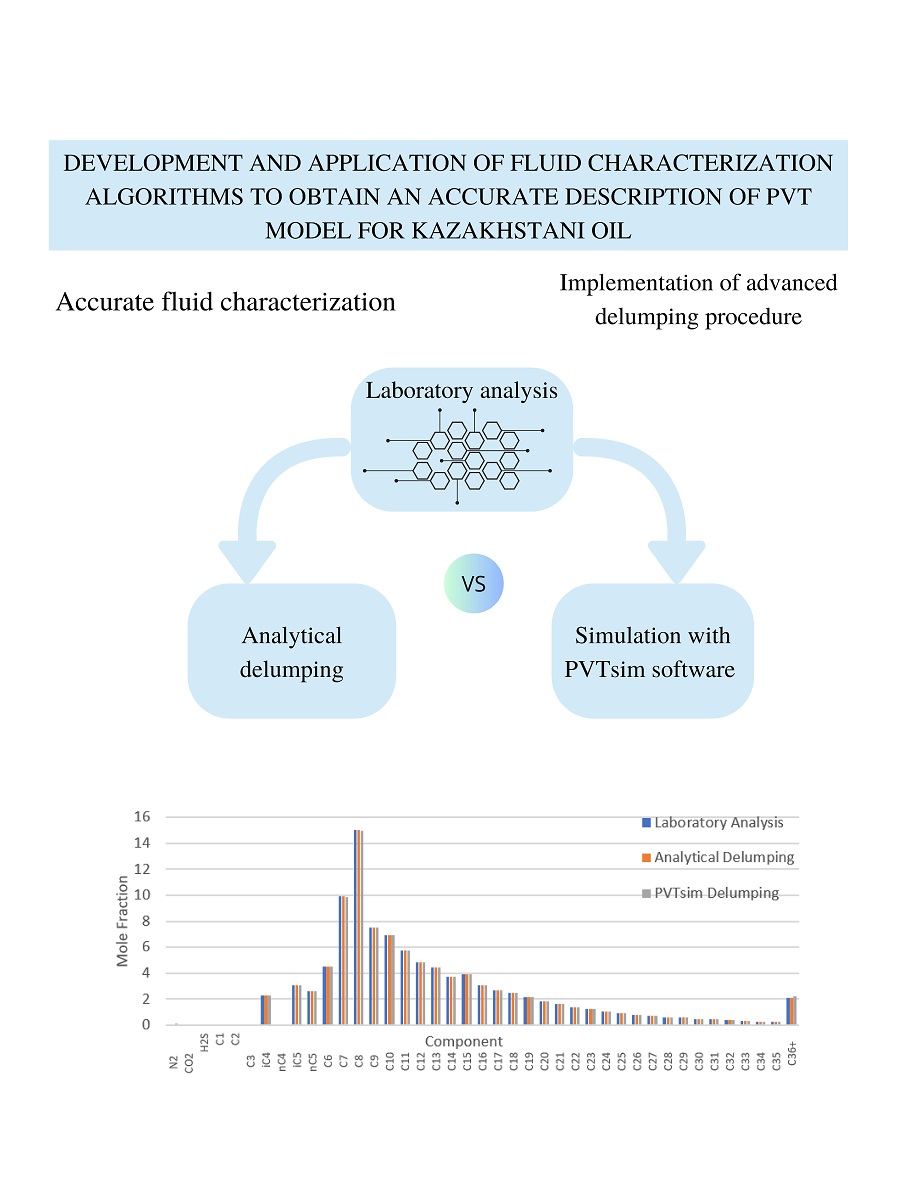Development and application of fluid characterization algorithms to obtain an accurate description of a PVT model for Kazakhstani oil
DOI:
https://doi.org/10.15587/1729-4061.2023.289932Keywords:
delumping, lumping, fluid description, fugacity coefficients, PVTsim software, pseudo-componentsAbstract
Compositional reservoir modeling often requires a large number of instantaneous calculations. To reduce the dimension of the problem and the amount of computation, several components are usually grouped into pseudo-components. However, to model surface processes, it is important to have a detailed phase composition. Accurate fluid composition requires laboratory analysis, which is costly and time-consuming. This study addresses this issue by introducing an advanced delumping procedure aimed at providing an accurate fluid characterization.
The primary objective was to develop a sophisticated delumping procedure capable of precisely describing detailed fluid compositions from calculations involving mixtures. Its goal is to reduce reliance on laboratory analysis, making the process more efficient. The results obtained from this research can improve the planning and modeling of surface facilities, developed under conditions of reservoir pressure above saturation pressure.
To test the effectiveness of the proposed delumping and achieve the goals set, experiments were carried out on compositional simulation of oil production in the Caspian basin. The procedure uses reduction parameters calculated from simulation data and an analytical approach to characterize fluid compositions from the original data. Detailed fluid compositions obtained through laboratory PVT analysis were then compared with the results of simulation using PVTsim software and numerical delumping procedures. The findings showed a close agreement between the outcomes of detailed compositions obtained through the delumping procedure and of laboratory analysis, with an average deviation less than 5 %, confirming the effectiveness of delumping as an alternative method for obtaining an accurate fluid composition
References
- Assareh, M., Ghotbi, C., Pishvaie, M. R., Mittermeir, G. M. (2013). An analytical delumping methodology for PC-SAFT with application to reservoir fluids. Fluid Phase Equilibria, 339, 40–51. doi: https://doi.org/10.1016/j.fluid.2012.11.025
- Nichita, D. V., Broseta, D., Leibovici, C. F. (2007). Reservoir fluid applications of a pseudo-component delumping new analytical procedure. Journal of Petroleum Science and Engineering, 59 (1-2), 59–72. doi: https://doi.org/10.1016/j.petrol.2007.03.003
- Schlijper, A. G., Drohm, J. K. (1988). Inverse Lumping: Estimating Compositional Data From Lumped Information. SPE Reservoir Engineering, 3 (03), 1083–1089. doi: https://doi.org/10.2118/14267-pa
- Danesh, A., Xu, D., Todd, A. C. (1992). A Grouping Method To Optimize Oil Description for Compositional Simulation of Gas-Injection Processes. SPE Reservoir Engineering, 7 (03), 343–348. doi: https://doi.org/10.2118/20745-pa
- Leibovici, C., Stenby, E. H., Knudsen, K. (1996). A consistent procedure for pseudo-component delumping. Fluid Phase Equilibria, 117 (1-2), 225–232. doi: https://doi.org/10.1016/0378-3812(95)02957-5
- Leibovici, C. F., Barker, J. W., Waché, D. (2000). Method for Delumping the Results of Compositional Reservoir Simulation. SPE Journal, 5 (02), 227–235. doi: https://doi.org/10.2118/64001-pa
- Nichita, D. V., Leibovici, C. F. (2006). An analytical consistent pseudo-component delumping procedure for equations of state with non-zero binary interaction parameters. Fluid Phase Equilibria, 245 (1), 71–82. doi: https://doi.org/10.1016/j.fluid.2006.03.016
- De Castro, D. T., Nichita, D. V., Broseta, D., Herriou, M., Barker, J. W. (2011). Improved Delumping of Compositional Simulation Results. Petroleum Science and Technology, 29 (1), 1–12. doi: https://doi.org/10.1080/10916460903330098
- Stenby, E. H., Christensen, J. R., Knudsen, K., Leibovici, C. (1996). Application of a Delumping Procedure to Compositional Reservoir Simulations. All Days. doi: https://doi.org/10.2118/36744-ms
- Barker, J. W., Leibovici, C. F. (1999). Delumping Compositional Reservoir Simulation Results: Theory and Applications. All Days. doi: https://doi.org/10.2118/51896-ms

Downloads
Published
How to Cite
Issue
Section
License
Copyright (c) 2023 Jamilyam Ismailova, Dinara Delikesheva, Aibek Abdukarimov, Nargiz Zhumanbetova, Adel Sarsenova

This work is licensed under a Creative Commons Attribution 4.0 International License.
The consolidation and conditions for the transfer of copyright (identification of authorship) is carried out in the License Agreement. In particular, the authors reserve the right to the authorship of their manuscript and transfer the first publication of this work to the journal under the terms of the Creative Commons CC BY license. At the same time, they have the right to conclude on their own additional agreements concerning the non-exclusive distribution of the work in the form in which it was published by this journal, but provided that the link to the first publication of the article in this journal is preserved.
A license agreement is a document in which the author warrants that he/she owns all copyright for the work (manuscript, article, etc.).
The authors, signing the License Agreement with TECHNOLOGY CENTER PC, have all rights to the further use of their work, provided that they link to our edition in which the work was published.
According to the terms of the License Agreement, the Publisher TECHNOLOGY CENTER PC does not take away your copyrights and receives permission from the authors to use and dissemination of the publication through the world's scientific resources (own electronic resources, scientometric databases, repositories, libraries, etc.).
In the absence of a signed License Agreement or in the absence of this agreement of identifiers allowing to identify the identity of the author, the editors have no right to work with the manuscript.
It is important to remember that there is another type of agreement between authors and publishers – when copyright is transferred from the authors to the publisher. In this case, the authors lose ownership of their work and may not use it in any way.









